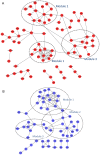Prediction of key genes and miRNAs responsible for loss of muscle force in patients during an acute exacerbation of chronic obstructive pulmonary disease
- PMID: 28025995
- PMCID: PMC5065306
- DOI: 10.3892/ijmm.2016.2761
Prediction of key genes and miRNAs responsible for loss of muscle force in patients during an acute exacerbation of chronic obstructive pulmonary disease
Abstract
The present study aimed to identify genes and microRNAs (miRNAs or miRs) that were abnormally expressed in the vastus lateralis muscle of patients with acute exacerbations of chronic obstructive pulmonary disease (AECOPD). The gene expression profile of GSE10828 was downloaded from the Gene Expression Omnibus database, and this dataset was comprised of 4 samples from patients with AECOPD and 5 samples from patients with stable COPD. Differentially expressed genes (DEGs) were screened using the Limma package in R. A protein‑protein interaction (PPI) network of DEGs was built based on the STRING database. Module analysis of the PPI network was performed using the ClusterONE plugin and functional analysis of DEGs was conducted using DAVID. Additionally, key miRNAs were enriched using gene set enrichment analysis (GSEA) software and a miR-gene regulatory network was constructed using Cytoscape software. In total, 166 up- and 129 downregulated DEGs associated with muscle weakness in AECOPD were screened. Among them, NCL, GOT1, TMOD1, TSPO, SOD2, NCL and PA2G4 were observed in the modules consisting of upregulated or downregulated genes. The upregulated DEGs in modules (including KLF6 and XRCC5) were enriched in GO terms associated with immune system development, whereas the downregulated DEGs were enriched in GO terms associated with cell death and muscle contraction. Additionally, 39 key AECOPD‑related miRNAs were also predicted, including miR-1, miR-9 and miR-23a, miR-16 and miR-15a. In conclusion, DEGs (NCL, GOT1, SOD2, KLF6, XRCC5, TSPO and TMOD1) and miRNAs (such as miR-1, miR-9 and miR-23a) may be associated with the loss of muscle force in patients during an acute exacerbation of COPD which also may act as therapeutic targets in the treatment of AECOPD.
Figures





Similar articles
-
Exploring the molecular mechanisms of osteosarcoma by the integrated analysis of mRNAs and miRNA microarrays.Int J Mol Med. 2018 Jul;42(1):21-30. doi: 10.3892/ijmm.2018.3594. Epub 2018 Mar 27. Int J Mol Med. 2018. PMID: 29620143 Free PMC article.
-
Gene expression profiling via bioinformatics analysis reveals biomarkers in laryngeal squamous cell carcinoma.Mol Med Rep. 2015 Aug;12(2):2457-64. doi: 10.3892/mmr.2015.3701. Epub 2015 Apr 29. Mol Med Rep. 2015. PMID: 25936657 Free PMC article.
-
Investigation of crucial genes and microRNAs in conventional osteosarcoma using gene expression profiling analysis.Mol Med Rep. 2017 Nov;16(5):7617-7624. doi: 10.3892/mmr.2017.7506. Epub 2017 Sep 18. Mol Med Rep. 2017. PMID: 28944822
-
Identification of potential microRNAs and KEGG pathways in denervation muscle atrophy based on meta-analysis.Sci Rep. 2021 Jun 30;11(1):13560. doi: 10.1038/s41598-021-92489-1. Sci Rep. 2021. PMID: 34193880 Free PMC article.
-
Potential Mechanisms Between HF and COPD: New Insights From Bioinformatics.Curr Probl Cardiol. 2023 Mar;48(3):101539. doi: 10.1016/j.cpcardiol.2022.101539. Epub 2022 Dec 15. Curr Probl Cardiol. 2023. PMID: 36528207 Review.
Cited by
-
Differential patterns of cross-reactive antibody response against SARS-CoV-2 spike protein detected for chronically ill and healthy COVID-19 naïve individuals.Sci Rep. 2022 Oct 7;12(1):16817. doi: 10.1038/s41598-022-20849-6. Sci Rep. 2022. PMID: 36207326 Free PMC article.
-
MicroRNA molecules as predictive biomarkers of adaptive responses to strength training and physical inactivity in haemodialysis patients.Sci Rep. 2020 Sep 24;10(1):15597. doi: 10.1038/s41598-020-72542-1. Sci Rep. 2020. PMID: 32973233 Free PMC article.
-
TSPO PET Imaging: From Microglial Activation to Peripheral Sterile Inflammatory Diseases?Contrast Media Mol Imaging. 2017 Sep 25;2017:6592139. doi: 10.1155/2017/6592139. eCollection 2017. Contrast Media Mol Imaging. 2017. PMID: 29114179 Free PMC article. Review.
-
Mechanisms by Which the MBD2/miR-301a-5p/CXCL12/CXCR4 Pathway Regulates Acute Exacerbations of Chronic Obstructive Pulmonary Disease.Int J Chron Obstruct Pulmon Dis. 2020 Oct 19;15:2561-2572. doi: 10.2147/COPD.S261522. eCollection 2020. Int J Chron Obstruct Pulmon Dis. 2020. PMID: 33116473 Free PMC article.
-
Bioinformatics-based identification of potential microRNA biomarkers in frequent and non-frequent exacerbators of COPD.Int J Chron Obstruct Pulmon Dis. 2018 Apr 16;13:1217-1228. doi: 10.2147/COPD.S163459. eCollection 2018. Int J Chron Obstruct Pulmon Dis. 2018. PMID: 29713155 Free PMC article.
References
-
- Vestbo J, Hurd SS, Agustí AG, Jones PW, Vogelmeier C, Anzueto A, Barnes PJ, Fabbri LM, Martinez FJ, Nishimura M, et al. Global strategy for the diagnosis, management, and prevention of chronic obstructive pulmonary disease: GOLD executive summary. Am J Respir Crit Care Med. 2013;187:347–365. doi: 10.1164/rccm.201204-0596PP. - DOI - PubMed
-
- Uzun S, Djamin R, Hoogsteden H, Aerts J, van der Eerden M. Acute exacerbations of chronic obstructive pulmonary disease. In: Kayembe JM, editor. Oncogenesis, Inflammatory and Parasitic Tropical Diseases of the Lung. InTech; 2013. pp. 77–98. Chapter 4. http://dx.doi.org/10.5772/54867. - DOI
-
- Carrillo A, Ferrer M, Gonzalez-Diaz G, Lopez-Martinez A, Llamas N, Alcazar M, Capilla L, Torres A. Noninvasive ventilation in acute hypercapnic respiratory failure caused by obesity hypoventilation syndrome and chronic obstructive pulmonary disease. Am J Respir Crit Care Med. 2012;186:1279–1285. doi: 10.1164/rccm.201206-1101OC. - DOI - PubMed
-
- Lozano R, Naghavi M, Foreman K, Lim S, Shibuya K, Aboyans V, Abraham J, Adair T, Aggarwal R, Ahn SY, et al. Global and regional mortality from 235 causes of death for 20 age groups in 1990 and 2010: A systematic analysis for the Global Burden of Disease Study 2010. Lancet. 2012;380:2095–2128. doi: 10.1016/S0140-6736(12)61728-0. - DOI - PMC - PubMed
MeSH terms
Substances
LinkOut - more resources
Full Text Sources
Other Literature Sources
Medical
Research Materials
Miscellaneous

